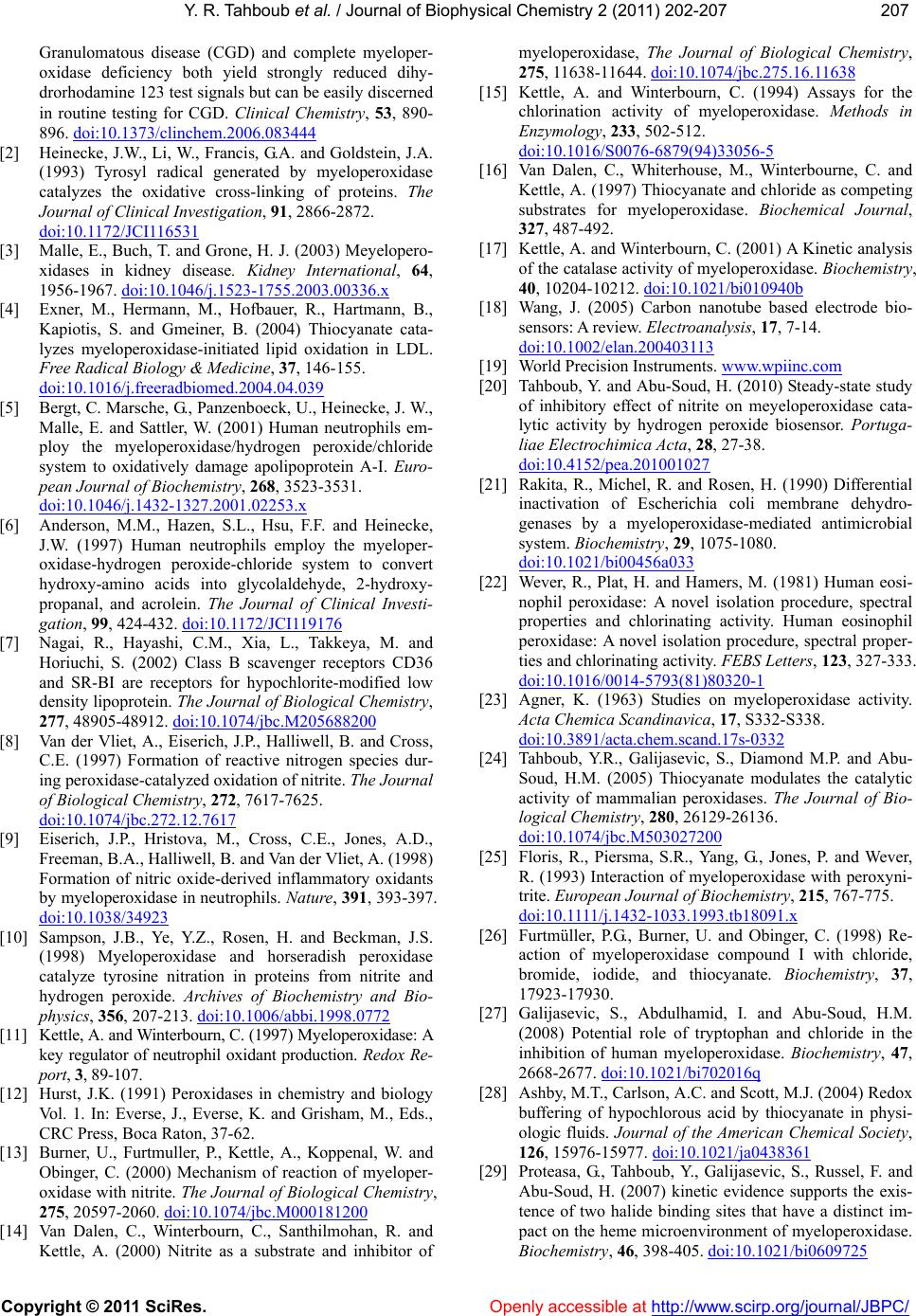
Y. R. Tahboub et al. / Journal of Biophysical Chemistry 2 (2011) 202-207
Copyright © 2011 SciRes. Openly accessible at http://www.scirp.org/journal/JBPC/
207207
Granulomatous disease (CGD) and complete myeloper-
oxidase deficiency both yield strongly reduced dihy-
drorhodamine 123 test signals but can be easily discerned
in routine testing for CGD. Clinical Chemistry, 53, 890-
896. doi:10.1373/clinchem.2006.083444
[2] Heinecke, J.W., Li, W., Francis, G.A. and Goldstein, J.A.
(1993) Tyrosyl radical generated by myeloperoxidase
catalyzes the oxidative cross-linking of proteins. The
Journal of Clinical Investigation, 91, 2866-2872.
doi:10.1172/JCI116531
[3] Malle, E., Buch, T. and Grone, H. J. (2003) Meyelopero-
xidases in kidney disease. Kidney International, 64,
1956-1967. doi:10.1046/j.1523-1755.2003.00336.x
[4] Exner, M., Hermann, M., Hofbauer, R., Hartmann, B.,
Kapiotis, S. and Gmeiner, B. (2004) Thiocyanate cata-
lyzes myeloperoxidase-initiated lipid oxidation in LDL.
Free Radical Biology & Medicine, 37, 146-155.
doi:10.1016/j.freeradbiomed.2004.04.039
[5] Bergt, C. Marsche, G., Panzenboeck, U., Heinecke, J. W.,
Malle, E. and Sattler, W. (2001) Human neutrophils em-
ploy the myeloperoxidase/hydrogen peroxide/chloride
system to oxidatively damage apolipoprotein A-I. Euro-
pean Journal of Biochemistry, 268, 3523-3531.
doi:10.1046/j.1432-1327.2001.02253.x
[6] Anderson, M.M., Hazen, S.L., Hsu, F.F. and Heinecke,
J.W. (1997) Human neutrophils employ the myeloper-
oxidase-hydrogen peroxide-chloride system to convert
hydroxy-amino acids into glycolaldehyde, 2-hydroxy-
propanal, and acrolein. The Journal of Clinical Investi-
gation, 99, 424-432. doi:10.1172/JCI119176
[7] Nagai, R., Hayashi, C.M., Xia, L., Takkeya, M. and
Horiuchi, S. (2002) Class B scavenger receptors CD36
and SR-BI are receptors for hypochlorite-modified low
density lipoprotein. The Journal of Biological Chemistry,
277, 48905-48912. doi:10.1074/jbc.M205688200
[8] Van der Vliet, A., Eiserich, J.P., Halliwell, B. and Cross,
C.E. (1997) Formation of reactive nitrogen species dur-
ing peroxidase-catalyzed oxidation of nitrite. The Journal
of Biological Chemistry, 272, 7617-7625.
doi:10.1074/jbc.272.12.7617
[9] Eiserich, J.P., Hristova, M., Cross, C.E., Jones, A.D.,
Freeman, B.A., Halliwell, B. and Van der Vliet, A. (1998)
Formation of nitric oxide-derived inflammatory oxidants
by myeloperoxidase in neutrophils. Nature, 391, 393-397.
doi:10.1038/34923
[10] Sampson, J.B., Ye, Y.Z., Rosen, H. and Beckman, J.S.
(1998) Myeloperoxidase and horseradish peroxidase
catalyze tyrosine nitration in proteins from nitrite and
hydrogen peroxide. Archives of Biochemistry and Bio-
physics, 356, 207-213. doi:10.1006/abbi.1998.0772
[11] Kettle, A. and Winterbourn, C. (1997) Myeloperoxidase: A
key regulator of neutrophil oxidant production. Redox Re-
port, 3, 89-107.
[12] Hurst, J.K. (1991) Peroxidases in chemistry and biology
e, A., Koppenal, W. and
Vol. 1. In: Everse, J., Everse, K. and Grisham, M., Eds.,
CRC Press, Boca Raton, 37-62.
[13] Burner, U., Furtmuller, P., Kettl
Obinger, C. (2000) Mechanism of reaction of myeloper-
oxidase with nitrite. The Journal of Biological Chemistry,
275, 20597-2060. doi:10.1074/jbc.M000181200
[14] Van Dalen, C., Winterbourn, C., Santhilmohan, R. and
Kettle, A. (2000) Nitrite as a substrate and inhibitor of
myeloperoxidase, The Journal of Biological Chemistry,
275, 11638-11644. doi:10.1074/jbc.275.16.11638
[15] Kettle, A. and Winterbourn, C. (1994) Assays for the
3056-5
chlorination activity of myeloperoxidase. Methods in
Enzymology, 233, 502-512.
doi:10.1016/S0076-6879(94)3
e, C. and
interbourn, C. (2001) A Kinetic analysis
[16] Van Dalen, C., Whiterhouse, M., Winterbourn
Kettle, A. (1997) Thiocyanate and chloride as competing
substrates for myeloperoxidase. Biochemical Journal,
327, 487-492.
[17] Kettle, A. and W
of the catalase activity of myeloperoxidase. Biochemistry,
40, 10204-10212. doi:10.1021/bi010940b
[18] Wang, J. (2005) Carbon nanotube based electrode bio-
sensors: A review. Electroanalysis, 17, 7-14.
doi:10.1002/elan.200403113
[19] World Precision Instruments. www.wpiinc.com
e study [20] Tahboub, Y. and Abu-Soud, H. (2010) Steady-stat
of inhibitory effect of nitrite on meyeloperoxidase cata-
lytic activity by hydrogen peroxide biosensor. Portuga-
liae Electrochimica Acta, 28, 27-38.
doi:10.4152/pea.201001027
[21] Rakita, R., Michel, R. and Rosen, H. (1990) Differential
inactivation of Escherichia coli membrane dehydro-
genases by a myeloperoxidase-mediated antimicrobial
system. Biochemistry, 29, 1075-1080.
doi:10.1021/bi00456a033
[22] Wever, R., Plat, H. and Hamers, M. (1981) Human eosi-
nophil peroxidase: A novel isolation procedure, spectral
properties and chlorinating activity. Human eosinophil
peroxidase: A novel isolation procedure, spectral proper-
ties and chlorinating activity. FEBS Letters, 123, 327-333.
doi:10.1016/0014-5793(81)80320-1
[23] Agner, K. (1963) Studies on myeloperoxidase activity.
Acta Chemica Scandinavica, 17, S332-S338.
doi:10.3891/acta.chem.scand.17s-0332
[24] Tahboub, Y.R., Galijasevic, S., Diamond M.P. and Abu-
Soud, H.M. (2005) Thiocyanate modulates the catalytic
activity of mammalian peroxidases. The Journal of Bio-
logical Chemistry, 280, 26129-26136.
doi:10.1074/jbc.M503027200
[25] Floris, R., Piersma, S.R., Yang, G., Jones, P. and Wever,
R. (1993) Interaction of myeloperoxidase with peroxyni-
trite. European Journal of Biochemistry, 215, 767-775.
d oi :1 0. 1111/ j. 14 32 -1033.1993.tb18091.x
[26] Furtmüller, P.G., Burner, U. and Obinger, C. (1998) Re-
, Abdulhamid, I. and Abu-Soud, H.M.
action of myeloperoxidase compound I with chloride,
bromide, iodide, and thiocyanate. Biochemistry, 37,
17923-17930.
[27] Galijasevic, S.
(2008) Potential role of tryptophan and chloride in the
inhibition of human myeloperoxidase. Biochemistry, 47,
2668-2677. doi:10.1021/bi702016q
[28] Ashby, M.T., Carlson, A.C. and Scott, M.J. (2004) Redox
buffering of hypochlorous acid by thiocyanate in physi-
ologic fluids. Journal of the American Chemical Society,
126, 15976-15977. doi:10.1021/ja0438361
[29] Proteasa, G., Tahboub, Y., Galijasevic, S., Russel, F. and
Abu-Soud, H. (2007) kinetic evidence supports the exis-
tence of two halide binding sites that have a distinct im-
pact on the heme microenvironment of myeloperoxidase.
Biochemistry, 46, 398-405. doi:10.1021/bi0609725